Ariane Maugery, Guy Le Lay – Micro-gravity oddity: A Space Art and Science Genesis – 2005
A. Maugery, Artist – G. Le Lay, Scientist
First publication workshop The Impact of Space on Society: Cultural Aspects, in
collaboration with IAA and Millenaris, Budapest, 2005
«Etre dans une œuvre de l’homme comme poissons dans l’onde, en être entièrement baigné, y vivre, et lui appartenir. »
(«To be inside an artwork like fishes under waves, to be fully immersed, to live in it and to belong to it. »)
Paul Valery, Eupalinos ou l’Architecte
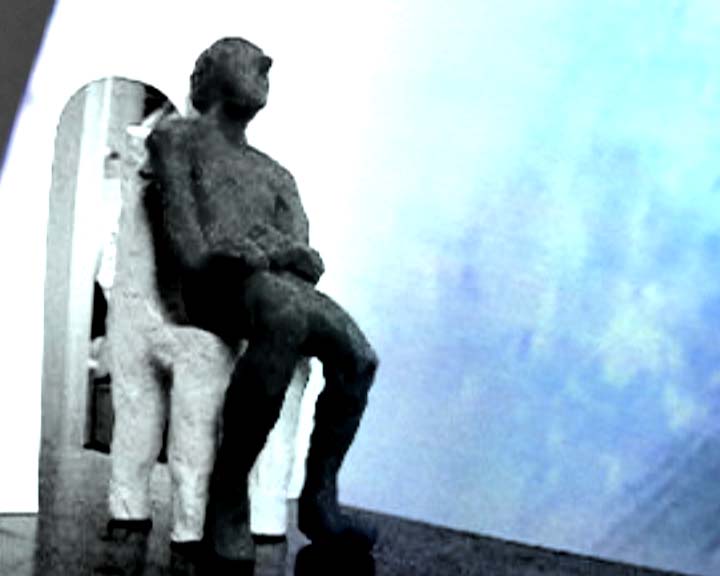
Micro-gravity oddity, video capture, 2005
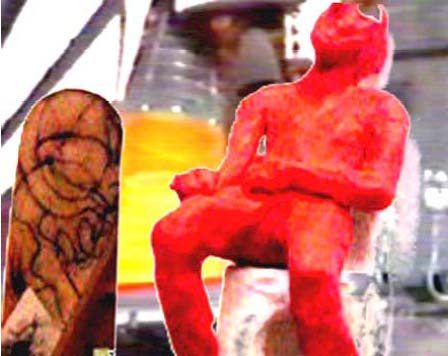
Micro-gravity oddity, video capture, 2005
Micro-gravity oddity is a video-arabesque which was realized in the context of the World Year of Physics 2005 (WYP-05), under the auspices of UNESCO and UNO. This creation reflects the conjunction of an artist’s practice (A.M.) while collaborating with a physicist (GLL) who was the co-Principal Investigator of an experiment that flew in the first International Microgravity Laboratory (IML-1) on board the shuttle « Discovery » in January 1992: the Mercuric Iodide Crystal Growth experiment.
Starting from films and a large number of photographs taken on board and out of the Shuttle by the crew during the flight, A.M. made this artistic video film which will be projected outdoors, at giant scales, on such world known places as the Palais des Papes in Avignon during the international theatre festival, the roman arenas in Arles during the ferias and the famous photo festival, on the occasion of the opening of the Centre Chorégraphique National in Aix-en-Provence, the fortifications around the Vieux-Port in Marseille, and even the Stadium of the « Olympique de Marseille », the most famous French soccer team.
The aim of WIP-05, also known as Einstein Year because of the Centennial Anniversary of the theory of special relativity, of the photoelectric effect and of the Brownian motion, is to attract the attention of a vast public and to generate interest in sciences and especially in physics. Obviously, Space Art in relation to creative science is a fantastic tool, having a strong societal impact: a testimony is the captured attention of such different audiences as afficionados, soccer fans, contemporary dance amateurs or theatre and photograph enthusiasts.
Albert Einstein’s greatest contribution to humanity is the discovery that matter and energy are inter-convertible. Matter appears, changes and disappears. Nothing is solid, not even a rock. Atoms and electrons in a rock are subtle and alive, just as the ocean is. Each image is in a constant state of flux. Composing a multiplicity of layers, as successive waves, or through a sudden qualitative change, as for a phase transition, liquid droplets develop into fluid architectures. Sound and visual constellations in the video express the accelerated expansion of an ex-foliated universe.
Sitting on his cloudy chair, a hallucinated personage shifts from a situation of gravity to a floating state in weightlessness conditions which reveals his entrance into a state of dance. The entanglement of the actual impressions of a floating imbalance and of a specific state of concentration constitutes an intensive, rhythmic experience.
Sounds and visuals swirl in the perception of these time-based images. They coexist in a synergetic vibrant atmosphere which strengthens the emotional appropriation of space-time.
Built from energy quanta, this video explores critical points, the various levels of temporal awareness of a hypnotized diver who has physically experienced the lift-off of the shuttle taking-off from earth. Feeling himself carried away by a temporal drift, the diver transcribes the spatial situation of his own presence as a blind person. This kind of distraction, of musical blindness, based on a lucid trance emerges from a “hyperfine sensitivity” (1) which resonates with usually imperceptible molecular movements. Entering a state of weightlessness, like entering a state of dance, probably needs a special form of consciousness, a kind of copernician or rather einsteinian revolution: a kind of spatial relativity. In microgravity, the body is an actor at the mercy of waves, a phantom vessel, a Fliegende Hollander. Floating inside the shuttle, the astronauts move in microgravity as in a dance performance. These improvised spiralling movements have a strong suggestive power and are a source of inspiration in research on time-based art and time perception problems.
On earth, expanding his energy from his nodal centre the dancing body is exquisitively tuned to gravity at variable fragile levels. In micro-gravity, it maintains an energetic contact with the local environment, although literally a-centred, floating in media res. His attention requires in a synesthesic manner all sensorial powers. The development of dance in microgravity provides a paradigm of the real experience of improvisation. It destroys every standard frame, opens up new perspectives at a culminating degree. Moving in weightlessness conditions no longer depends on reasonable constraints and codes; a dancing movement is per se self-generated.
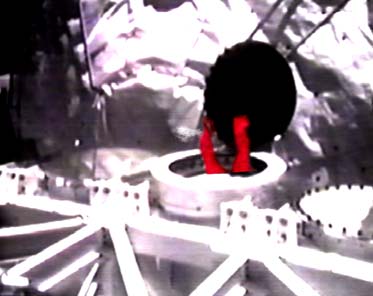
Micro-gravity oddity, video capture, 2005
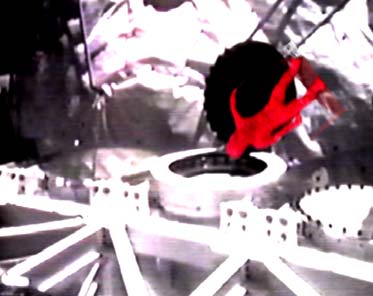
To improvise consists in the enactive, funambulist approach of being on the verge of disruptive vertigo. It just maintains a very delicate balance, while the spatio-temporal horizon evades. Still, it needs a dimension of anticipation, an acute state of fleeting consciousness. This pure attention, this pure effect of presence reveals that in altered gravity dancing is not reducible to a central, individual and soliloquy pilot. It relies on the vigilant sensation of the natural fluidity of the movement. This free stream of consciousness, is a fundamental condition to access to the present, “nothing but that single fleeting moment when you feel alive” (2) which qualifies a state of dance and requires full immersion within intricate waves. This experimentation can be considered as a reduction to the essential; it transcripts and confirms the ontological fact of the precedence of movement on the essence and operates with a thought of immanence.
Proposed few years ago for parabolic flights in Moscow, the project Fluid ephemeral sculpture/architecture in zero gravity intended to create liquid architectures with fluids of different viscosities during the short durations of nearly 0-g.The concept started from the terms « Cathédrales Liquides » (Liquid Cathedrals) from the well-known contemporary poet and painter Henri Michaux (3), inspired by the mental vertigo produced by mescaline. It was not selected because of its too high complexity, but its spirit is preserved in Micro-gravity oddity. The idea was to realize fluid sculptures that would develop finally into a fluid architecture, during the few seconds of absence of gravity. At the end of each parabola, the fluid artwork, suspended in air, which would eventually suffer from Rayleigh instabilities, would collapse. The project aimed at the realization of a kind of dance, materialized in a video creation, reflecting the hypnotic movement produced by “modulation par immersion” (4); i.e. by modulated degrees of immersion, in the very specific context of a floating space-time. The ancient Greeks called kaïros such unpredictable, auspicious, fluctuating ambiences.
In fact the microgravity conditions appear really close to the realization of immersive environments which drive the spectator to abandon his position as an observer so as to sink in a diffuse participation as embedded spect-actor. Multi-screens installations by video-makers (5) or by choreographers (6) create de facto transitional, shifting states which demand the spectators a predisposition to dancing. Along with this immersion in a space-time where different velocities coexist, wrapping the spectator in strange attractors at scattered, syncopated sound and visual crossings, the movement gets denser, disseminates unexplored bifurcations and suggests a kind of ghost matter and black energy. As it flows, time becomes stratified, rich of folded internal dimensions which overload the present with a regenerated past. From this meandering, basic sequential modules emerge; elementary entities condense in latency the possibility to be replayed in other consistent contexts. They develop various temporal thicknesses which will be soon integrated in more complex performing environments, in some sort of liquid architectures, like Ultra-relativistic e-motion, a novel creation, where dancers from the Ballet Preljocaj will be filmed while interacting in real time and dancing in a “kaïrotic” spirit of free fall.
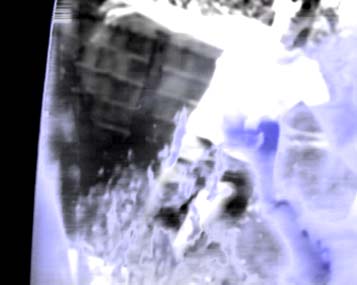
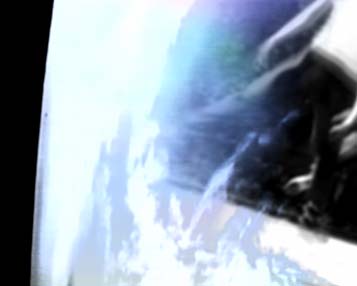
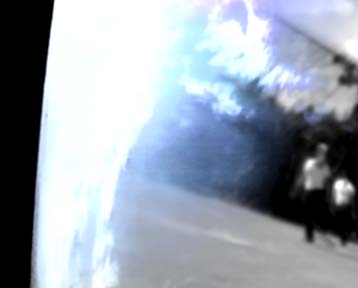
Micro-gravity oddity, video capture, 2005
Real and virtual facts, like particles, are in a continuous exchange linking two times inside and outside Discovery. Gilles Deleuze defined memory processes as “virtual coexistences” (7) in so far as coagulated traces following lines of tension coexist in a foliated time. It produces in corpore a feeling of duration in a perpetual transformation, as foam induces a wavy threshold of perception. Because of the distracting coexistence of reality and virtuality, all events appear simultaneously actual and potential. This conjunction of different modalities creates a hypnotic effect which amplifies or paralyses the instantaneous “hic et nunc”.
This visible juxtaposition of various temporal layers, the parallel temporal and factual flows, reveal that dance never acts in an one-dimensional time. On the contrary a superimposition of variable durations, a proliferation of times looms up. In this topologically complex shattered multiverse, no one can only be an observer. The spectator is totally immersed in moving patterns, entangled in temporal fragments where interacting “particles” unceasingly exchange energy and shift their time scale. At some corporal moments in a sort of oceanic ensemble, we feel like being swallowed into a multi-dimensional cyclone eye. Yet, suddenly at abrupt phase transitions, it seems that we are ejected from such black holes. As expressed by Henri Michaux “Je sens – comment dire – comme une pression de singularité” (8). (I feel -how to say- like a pressure of singularity.)
Notes :
(1) – According to the terms “sensiblilité surfine” of Vladimir Jankélévitch.
(2) – Merce Cunnngham in The Twentieth Century Reader.
(3) – « Jamais soucoupe volante, plus démente, ne tourna magnésienne, aluminiée dans un ciel déchiré,/ comme une goutte brûlante… Jamais cinglement des fusées, des éléments éclatés, des évidences extraordinaires, plus torrentiellement ne dévala contre moi/ Jamais surprise et admiration d’enfants, braillant dans une barrique, ne réunit joie gonflée de tant d’échos, de ronflements, de renflements d’orage, de senteurs, de retours à d’autres âges, de vrilles, de ravages dans les lignes droites, de brassages, de retours à la caverne… là où déboulent les meutes, où les cathédrales sont liquides et en formation… », Henri Michaux, Face aux verrous, « Dans le cercle brisant de la jeune magicienne », Bibliothèque de La Pléiade, Editions Gallimard, 2001, p.498.
(4) – Paul Valery in 1921 on the essence of architecture as “modulation par immersion”.
(5) – As Pipilotti Rist or Groupes Dunes.
(6) – As N+N Corsino in Topologies de l’instant created in 2001.
(7) – Gilles Deleuze in Le Bergsonisme, PUF.
(8) – Henri Michaux, L’infini turbulent, La Pléiade, 2001, p.829.
© Ariane MAUGERY and Guy LE LAY & Leonardo/Olats, mars 2005 / republished 2023
Leonardo/Olats
Observatoire Leonardo des Arts et des Techno-Sciences
À propos / About | Lettre d'information Olats News



Pour toute (re)publication, merci de contacter / For any (re)publication, please contact Annick Bureaud: info@olats.org
Pour toute question concernant le site, merci de contacter / For any issue about the website, please contact: webmaster@olats.org
Design Thierry Fournier
© Association Leonardo 1997-2022